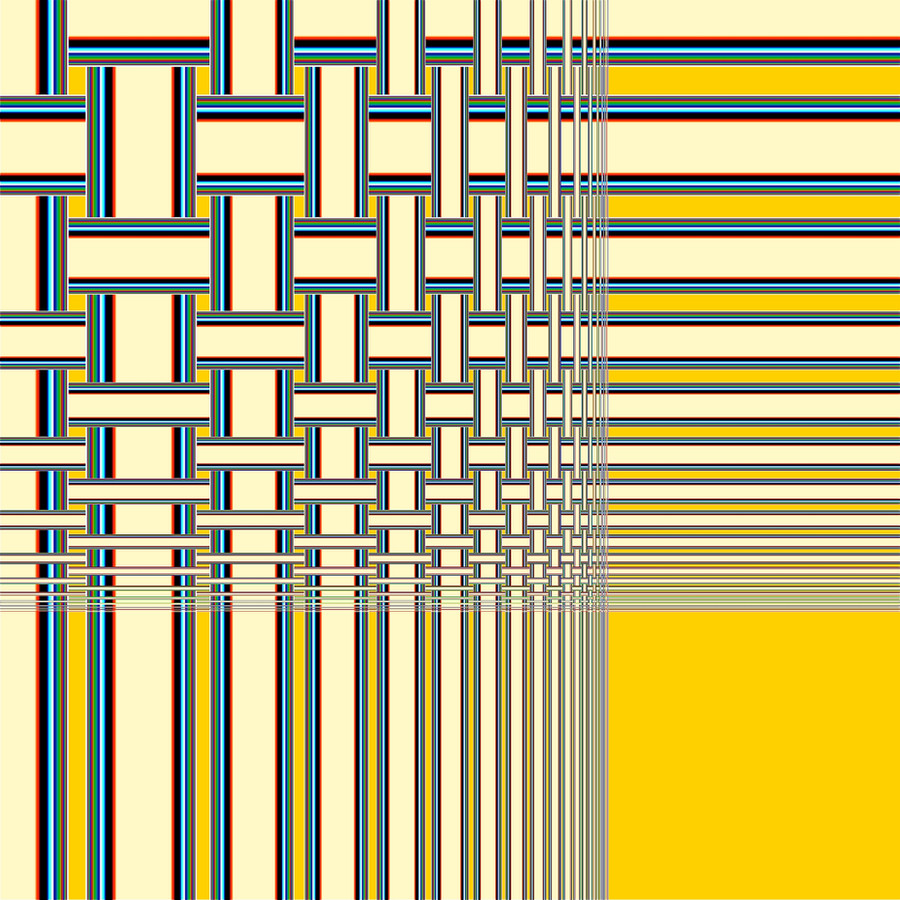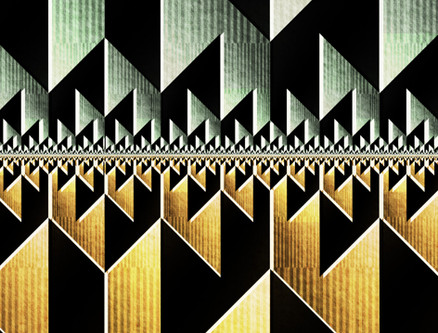HOME | DD
 Kancano — Weaving Pattern
Kancano — Weaving Pattern

Published: 2011-01-10 21:23:21 +0000 UTC; Views: 3343; Favourites: 28; Downloads: 307
Redirect to original
Description
"Weaving Pattern" was created with Quadrium2.Related content
Comments: 12

The same symbolism was used in Egypt.
If we look at the depiction of hieroglyph N-T-R, a remarkable thing is visible: [link]
[ image from: [link] , p.18 ]
There is a connection between N-T-R as the continuous [wave] movement/flow/wave (depiction #1); essence, container/frame? (depiction #2); cloth [covering]/matter? (depiction #3) and some kind of [intelligent?] power/force (depiction #4).
To me N-T-R looks like some kind of Universal force which makes us embodied via the production of matter (our outer "garment") by vibrations/constant movement-flow of underlying fabric of Existence, while being this fabric itself and/or causing it to vibrate.
The constantly recurring symbolism of cloth, threads, vibrations/wave movement and all-pervading supreme force of some kind is noticeable in both India and Egypt.
It is very possible that these have something to do with Ether (not ether of Michelson and Morley experiment).
As follows from Sanskrit etymological comparisons and other resources, Ether:
- is most probably the Space itself;
- is empty [of everything manifested] because everything [manifested] relies on Ether as a base;
- is so subtle that nothing can interfere with it (because in a sense all is build upon it) - "aniruddhapatha";
- is that which is "not divided" ("anaGga") - hence continuity (wave?);
- is related to shabda (sound), and hence to the vibrations/waves;
- is the subtlest of 5 gross elements;
- was represented by dodecahedron in esoteric Greek sects;
- is the part of transformation sequence Mahat-tattva (total undifferentiated material energy) -> Ahamkara (false Ego) -> Buddhi (higher theistic mind) -> Manas (mechanistic mind) -> Akasha (Ether)-> Vayu (Air) -> Agni (Fire) -> Jala (Water) -> Prithvi (Earth) acc. to some of the Vedic sources;
- may possibly be translated as "brilliant" ("AkAsh") because of etymological connection with the "light" of Prakriti ("kAsh").
I just thought it might be interesting for you, since you bring up this ancient symbolism in names of your art
👍: 0 ⏩: 0

“In ether (akasha) are woven and interwoven all those worlds – the worlds that are above, below, and in between heaven and earth; all these worlds that were, that are, and that shall be.” (Brihadaranyaka Upanishad III.viii.4; Madhvacarya)
The Sanskrit words are otam for woven and protam for interwoven. Some translators use the word ‘pervade’ instead of woven, but the understanding is the same: “...the unmanifested [ether] pervades the manifested creation, like thread woven warp and woof in a cloth.” (Sivananda)
In the Bhagavad Gita (VII.7), Krishna speaks as the voice of the eternal One-ness: “On Me all this universe is strung, on a thread like clusters of jewels (or pearls).”
The Sanskrit word used in this verse (VII.7) is protam again, meaning ‘is strung’ or interwoven. This is the same word in the Brihadarayanka Upanishad (III.viii.4): “In ether (akasha) are woven and interwoven all those worlds.”
[ [link] ]
Rig Veda X.130. Creating/performing a Sacrifice
Author, acc. to anukramani - Prajapati Yajna (Yajna Prajapatya - Victim stemming from Prajapati). Theme, acc. to anukramani - the description of creation (bhavavrttam). Size - trishtubh, verse 1 - jagati. Ancient Indian tradition interprets this hymn as a Cosmogonic. It is telling about the origin of the sacrifice. First, a sacrifice is being compared to the process of textile/weaving the fabric (verses 1-3): the victim is a threads which are being spinned, they are being pulled on the frame and the shuttle weaves the cloth. This image/symbolism is typical for Rig Veda (cf. X, 90, 15).
2c ... pegs "mayukhah" - that which establishes/fixes a frame for weaving
3d ... accepted/took the god as sacrifice "yad deva devam ayajanta vicve" - another possible translation is: offered a sacrifice to the God
1. The sacrifice drawn out with threads on every side,
stretched by a hundred sacred ministers and one,—
This do these Fathers weave who hitherward are come:
they sit beside the warp and cry, Weave forth, weave back.
2 The Man extends it and the Man unbinds it:
even to this vault of heaven hath he outspun, it.
These pegs are fastened to the seat of worship:
they made the Sāma-hymns their weaving shuttles.
3 What were the rule, the order and the model?
What were the wooden fender and the butter?
What were the hymn, the chant, the recitation,
when to the God all Deities paid worship?
[ [link] ]
यो यज्ञो विश्वतस्तन्तुभिस्तत एकशतं देवकर्मेभिरायतः |
इमे वयन्ति पितरो य आययुः पर वयाप वयेत्यासते तते ||
पुमानेनं तनुत उत कर्णत्ति पुमान वि तत्ने अधि नाकेस्मिन |
इमे मयूखा उप सेदुरू सदः सामानि चक्रुस्तसराण्योतवे ||
कासीत परमा परतिमा किं निदानमाज्यं किमासीत्परिधिः क आसीत |
छन्दः किमासीत परौगं किमुक्थंयद देवा देवमयजन्त विश्वे ||
yo yajño viśvatastantubhistata
ekaśataṃ devakarmebhirāyataḥ |
ime vayanti pitaro ya āyayuḥ
pra vayāpa vayetyāsate tate ||
pumānenaṃ tanuta ut kṛṇatti
pumān vi tatne adhi nākeasmin |
ime mayūkhā upa sedurū sadaḥ
sāmāni cakrustasarāṇyotave ||
kāsīt pramā pratimā kiṃ
nidānamājyaṃ kimāsītparidhiḥ ka āsīt |
[ [link] ]
👍: 0 ⏩: 0




































